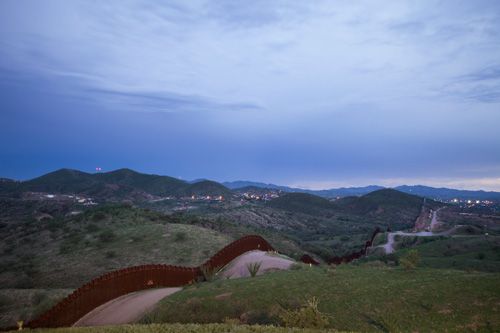At the Friday gallery opening for Gideon Mendel’s Deluge, I had grabbed a seat in front awaiting the artist’s talk when the artist himself appeared and encouraged us to first go and watch his 14 minute piece in full before returning for his talk.
A full fourteen minutes would usually test my patience for any single video piece- but the alien, overwhelming imagery coupled with constantly changing scenes spread out across five screens made the piece seem much shorter. When the piece looped back around to the beginning, I was sadly not yet ready for it to be over. There were scenes that were very human and intimate, with figures forlornly staring into the camera in the flooded remains of their house. Other scenes looked like something straight out of a post-apocalyptic film, featuring boats gliding through sunken cities. Still others were more purely visual, focusing on the way that reflection and the waterline changed the landscape on both large and small levels.
The artist’s talk following our viewing of the piece itself was quite enlightening about both Gideon Mendel’s process and personal reflections on the work. We learned that the project was over a decade in the making, and had originally been meant to cover all environmentally caused natural disasters, but then narrowed in focus. He also reminisced that he encountered an overwhelming sense of dissatisfaction with the government and the status quo regardless of where he went, whether it be the most affluent or the poorest neighborhood imaginable. I was struck by the equalizing power of natural disasters, not caring about the color of your skin, or your background. Although, and Mendel made sure to note this, those previously mentioned factors made a world of difference when it came to an individual’s ability to recover from said disaster.
One of the things that I appreciated the most out of the entire event, was when the artist was prompted to answer where he felt his work best fit between the worlds of photojournalism, environmental activism, and fine art. He instead insisted that his work not be pigeonholed into any one single realm, instead occupying a sort of middle ground. I could certainly see aspects of all three in his work, and agree that they were far more effective when used in harmony, rather than trying to merely fit only one category.
Another interesting element of this particular exposition was displayed in the utilization of the dual rooms. The main gallery space was used to very effectively show the video, completely darkened with benches to allow viewers to sit and enjoy the entire 14 minutes of the piece. The other room was used as a peek into Mendel’s behind the scenes process and organization of his material, with raw footage being played on projection and several wall installations on each of the walls. Over the course of the two weeks that Mendel was to be staying at UM, he was challenged by the gallery curator to experiment in arranging, rearranging, and adding to the walls, so they might appear different in a week’s time than they were when I photographed them. I was particularly inspired by the artfully arranged collection of photographs. The other wall was a play on the square format that is currently so ubiquitous due to influences such as Instagram.
Deluge will be displayed at the Institute for the Humanities Gallery right inside the entrance of the South Thayer Building until the end of the semester, December 18th. The gallery is only open from 9am-5pm M-F, so be sure to stop by in between classes and experience Gideon Mendel’s provoking piece for yourself. Also if your interest was piqued by this piece, definitely check out Gideon Mendel’s website (http://gideonmendel.com/) or check out his instagram @gideonmendel .













